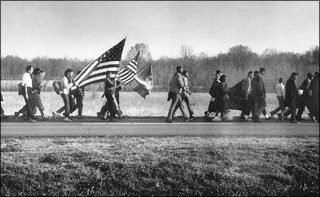 |  | Photo: Steve Schapiro |
What happened in Florida during the 2000 election shook Americans' confidence in our electoral process. But while the virtues of punchcards versus touch screens are debated, other flaws in the voting system get ignored. Some forty years after the civil rights movement, many Americans are still struggling to cast their votes.
In the spring of 1965, African Americans set out on a protest march from Selma, Alabama to the state capital in Montgomery. They were marching for the right to vote. They didn't get far. The first thing they saw as they left Selma was a sea of blue. The Alabama State Patrol had no intention of letting them cross the Edmund Pettis Bridge.
Major John Cloud of the Alabama State Troopers addressed the marchers, "This is an unlawful assembly. Go back to your church."
John Lewis, a young organizer was there as troopers advanced on the marchers, hitting them with nightsticks, trampling them with their horses and spraying them with teargas: "You saw these men putting on their gas masks..."
Across the nation Americans saw these violent, graphic images on television and many were outraged.
Soon after, President Lyndon Johnson signed the Voting Rights Act of 1965, which did away with literacy tests that kept blacks from voting across the South. The act also assigned federal monitors in areas where there had been discrimination and intimidation.
In many ways, the act was a huge success. African Americans elected black politicians to office in places where just two years earlier, no blacks had been allowed to vote. Twenty years after being beaten and bloodied in Alabama, John Lewis became a Democratic Congressman from Atlanta, Georgia. But in 2000, Lewis was still having trouble voting.
Congressman Lewis planned to vote in his working-class neighborhood in southwest Atlanta as soon as the polls opened --at 7 am-- before he went to work.
Lewis, who'd been voting at the Venetian Elementary School since 1968, arrived to find the polling place was still closed.
"There were people waiting," he explains, "so I jumped in my car and drove downtown and went to see the head of the Board of Elections and told her the precinct was not opened and she said, 'we will get it opened right away,' but I came back here and it was still not opened."
As it turned out, the lone poll worker with a key was an hour late. And when the poll finally did open, nearly half of the machines turned out to be broken, so the waiting continued. While this may not seem like a long time to wait, it is too long for people who have to get to work or get their children to school.
"It makes me angry," says Lewis, "People worked too hard and long to exercise this right and now the right to vote is being delayed and when it's delayed it's denied."
Next: MINORITY VOTES GO UNCOUNTED
| 
